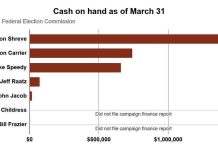Another Census of Agriculture is winding down, and — although the official deadline to respond was late January — I see that the United States Department of Agriculture is still welcoming responses.
While the roll-up of census data is critical to government decision-making, it’s interesting to look at results for your own area and get a snapshot of who’s raising what and where.
Of course, the USDA doesn’t publish names or individual information. In fact, their number crunchers are so careful about not revealing individual data that if there is, say, only one farmer raising a certain item in your county, the reports won’t disclose the data. A good example is shrimp.
During the 2007-2012 census period, Bartholomew County had one shrimp producer. Because there was only one, the county snapshot gave only the category, but didn’t disclose the sales numbers to protect the privacy of the farmer. To find any county profile, go online to agcensus.usda.gov/Publications/2012/Online_Resources/County_Profiles/.
Basics
With 623 farms covering more than 171,000 acres, Bartholomew County has 66 percent of its land devoted to agricultural production.
How does the USDA define a farm, you may ask? It’s an interesting definition. If you earned $1,000 or more, or would have, with your farm operation, you are a farmer and are asked to submit your information to the census.
So who are the Bartholomew County farmers? Out of 623 farms, the 2012 Census reports primary operators to be mostly white males. Others counted (or not) included:
- 55 women
- 11 Hispanic, Latino
- 6 multi-ethnic
- 0 Native American, Asian, or African-American
It’s also very telling that out of 623 primary operators, only 279 list farming as his or her primary occupation. Economics and market forces call farmers to off-farm jobs as a matter of course.
Rankings
Rankings are great to look at, especially if you are feeling competitive. At Purdue Extension, the rankings also can help us to assess needs for training, outreach and services. Bartholomew County had these rankings in the 2012 Census:
- 5, aquaculture
- 7, wheat
- 9, horses, mules, burros, or donkeys
- 15, vegetables & melon
- 18, tobacco
- 24, cut Christmas trees
- 38, soybeans
- 43, sheep and goat
- 44, corn
It’s amazing to note that some of these rankings were earned by individual producers, putting Bartholomew County on the map by the efforts of their farm alone. Of course, the Census of Agriculture won’t tell you their numbers, because that would reveal who they are.
Changes
So what changed since the 2007 Census of Agriculture? Here are a few points for Bartholomew County:
- Total number of farms down 4.3 percent
- Land in agriculture down 0.8 percent
- Average farm size up 3.8 percent
- Value of agricultural products up 32.8 percent
- 70 percent of farms earn less than $50,000
- Age of operators holding at about 57
Snapshot presentations
Because Extension works with every kind of agriculture, in all 92 Indiana counties, county Extension educators are well-acquainted with the census data for their county. We frequently make presentations on our county’s agricultural makeup, and I’m looking forward to updating mine with the new information from the 2017 Census of Agriculture, due out in early 2019.
But don’t wait! Contact me if your service club or organization would like to learn more about Bartholomew County agriculture.
Kris Medic is Purdue Extension Bartholomew County’s educator for agriculture, natural resources and community development. She can be reached at 812-379-1665 or [email protected].




